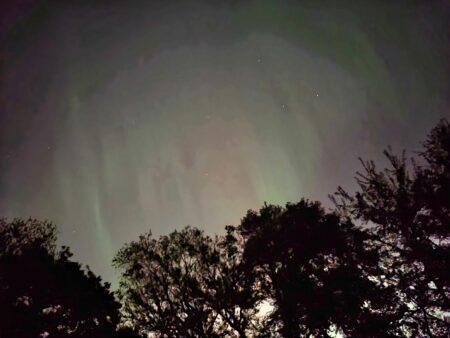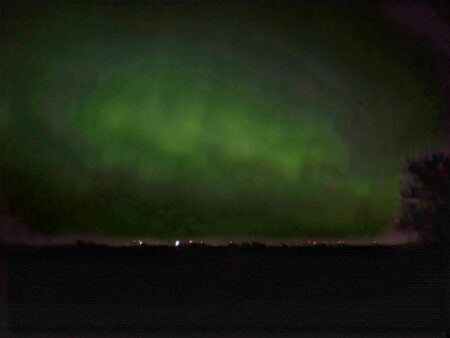Last night I saw the Northern Lights in Iowa which is not usual for us, but was due to some large solar flares. The first photo below is in my backyard which is close to city lights. The second photo was taken in the countryside north of Des Moines.


I uploaded two videos as well: https://www.youtube.com/watch?v=Bc0OnmNACw8 and https://www.youtube.com/watch?v=IONPDQrFsPw
Seeing the Northern Lights made me think of Iowa native James Van Allen, “The Father of Space Science.” https://physics.uiowa.edu/about/james-van-allen I’m not a big physics person, so I wrote the article below partly for myself so I could simplify and try to understand the Northern Lights which requires some knowledge about the Van Allen radiation belts that surround our earth. I wrote this essay many years ago so the references below are old and some no longer exist on the internet, but you can find most of this information on the NASA website.
FASTEN YOUR VAN ALLEN BELTS
For billions of years, our sun has been cooking hydrogen atoms at 27 million degrees Fahrenheit. As the hydrogen boils, molten atoms crash into each other and stick together to form helium atoms. Fusion! Bam! An enormous amount of nuclear energy explodes from the fused atoms.
The released energy causes the sun’s atomic soup to bubble up from its core, erupting in solar flares on the surface. A scorching solar wind blows across space, bathing the solar system in light, atomic particles, and radioactive waves such as ultraviolet rays, gamma rays, and X-rays.
The atomic particles in the solar wind are overly excited. There are untamed protons with positive charges. There are rogue electrons with negative charges. The radioactive atomic pieces bounce around like kids on a sugar high as they hurtle toward Earth.
Whoa! Mother Earth puts on the brakes. The overheated atoms are nabbed by the invisible belts that surround Earth’s equator like a life-preserver. Earth has two belts which are formed by the planet’s magnetic field.
Anyone who ever saw a compass knows that Earth has a magnetic field –a north and a south pole. The Earth’s magnetic pull reaches far out into space. The negatively and positively charged atoms, also called ions, flitting around in the solar wind are attracted to the strong magnetic current as they approach Earth. When the ions meet up with the Earth’s magnetic field, they hop on an electromagnetic roller coaster, flying back and forth between the north and south poles. The magnetism is so strong around the poles, that it stops the ions in their tracks and rockets them in the opposite direction. The ions cause the belts to be highly radioactive.
Radiation belts were discovered by Dr. James Van Allen, a scientist at the University of Iowa. For this reason, the belts around earth, especially the inner belt, are often called the Van Allen radiation belts.
In 1958, a rocket named Explorer I was sent into space with a Geiger counter to measure levels of radiation. With data collected from Explorer I and future missions, Dr. Van Allen was able to demonstrate the high levels of radiation which start 40 miles out from the surface of the Earth and extend out 40,000 miles. This area has been named the magnetosphere. The area beneath the magnetosphere is Earth’s atmosphere.
The outer radiation belt is the first obstacle for the solar wind. It is the weaker of the two belts and mainly holds on to electrons. The inner belt, which extends out to 4,000 miles, grabs the heavier protons which have more intense radioactivity.
The electromagnetic currents in the radiation belts are strong enough to turn off the electrical circuits of satellites and spaceships. The Van Allen belts also pose a risk for space travelers, since radiation causes damage to the human body. The strongest radiation starts at 300 miles from Earth. The International Space Station orbits below that, at 200 miles. The Apollo spaceships, which went to the moon, had to cross the radiation belts and leave the magnetosphere. To decrease radiation exposure to the astronauts, they had protective shields to deflect as many radioactive solar particles as possible. Apollo avoided travelling at times of high solar activity, and they passed through areas of the Van Allen belts with the lowest radiation.
We need sunlight (even if it does give us sunburns). Plants use the energy from sunlight to produce food and oxygen for us. But the radioactive particles that come from the sun are harmful to us. Scientifically speaking, it’s beautiful how the earth protects us with its own magnetic field.
And there’s one other beautiful thing about the radiation belts. If solar activity is high, the electromagnetic roller coaster gets crowded. When the roller coaster comes to an abrupt halt at the poles of the earth, some of those hyperactive ions are flung into the atmosphere where they crash into air molecules, mainly oxygen and nitrogen. The air molecules get atomic road rage and heat up until they glow. The result is the aurora borealis and the aurora australis, also known as the Northern and Southern Lights. The sun’s energy is transformed into a mystical dance of colors in the night sky. But, watch out. If you’re close to the auroras, you are in an area of intense electromagnetic activity, which means your compass, your radio, and your cell phone might quit working.
Earth is one wild ride. Luckily our safety belts are securely fastened.
BIBLIOGRAPHY
- “Radiation and the International Space Station: Recommendations to Reduce Risk (2000)” Commission on Physical Sciences, Mathematics, and Applications (CPSMA) and Space Studies Board (SSB).
- “Biomedical Results of Apollo” Section II. Chapter 3. Radiation Protection and Instrumentation by J. Vernon Bailey jsc.nasa.gov/books/Apollo/S2ch3.htm.
- “aurora borealis”, The Columbia Electronic Encyclopedia, 6th 2007.
- “Van Allen Radiation Belt” crystalinks.com/vanallenbelt.html.
- “Radiation Belts”, www-istp.gsfc.gov/Education/Iradbelt.html
- “Solar Radiation”, Encyclopedia of Earth, eoearth.org/article/solar_radiation.
- “Van Allen Radiaton Belts”, infoplease.comce6/sci/A0850404.html.
- “Where are the Van Allen radiation belts and are they important to life?”, astronomycafe.net/qadir/ask/a11789.html.
- “What is Starfish Prime?” wisegeek.com/what-is-starfish-prime.html.
- “What types of radiation are there?”, hps.org/publicinformation/ate/faqs/radiationtypes.html.
- “The Van Allen Belt”, imagine.gsfc.nasa.gov/docs/ask_astro/answers/970228a.html.
- “Sun”, Funk and Wagnalls New Encyclopedia Vol. 24, pages 439-443.
- “Radiation”, Funk and Wagnalls New Encyclopedia Vol 22, pages 67-70.


